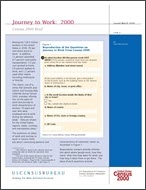Census 2000 Brief: Journey to Work: 2000
Census 2000 Brief: Journey to Work: 2000
Among the 128.3 million workers in the United States in 2000, 76 percent drove alone to work. In addition, 12 percent carpooled, 4.7 percent used public transportation, 3.3 percent worked at home, 2.9 percent walked to work, and 1.2 percent used other means (including motorcycle or bicycle).
This report, one of a series that presents population and housing data collected during Census 2000, provides information on the place-of-work and journey-to-work characteristics of workers 16 years and over who were employed and at work during the reference week.1 Data are shown for the United States, regions, states, counties, and metropolitan areas.2
The questions on place of work and journey to work in Census 2000 ask about commuting patterns and characteristics of commuter travel, as illustrated in Figure 1.
Respondents’ answers provide information about where people work, how they trav el, what time they leave for work, and how long it takes them to get there. The place-of-work questions provide information that is used to understand the geographic patterns of commuter travel and the volume of travel in “flows” between origins and destinations (e.g., home in a suburban county to work in a central city). The 1960 census was the first to ask place-of-work questions, including the name of the city or town where the work takes place, whether it is inside or outside the city limits, the name of the county, and the name of the state. Beginning with the 1970 census, the place-of-work information was expanded to include the street address and ZIP code of the work location. This information provides more precise data for transportation planners to use to address the increasing pressure on the national transportation infrastructure.
The question on usual means of transportation to work identifies the various types of transportation people use to get to their jobs. The “usual means” is defined as the one used on the most days in the previous week. The 1960 census, which was the first to include this question, asked for the one type of transportation used over the longest distance. The transportation categories changed somewhat between 1960 and 2000, but the question has remained essentially the same. The question on the number of people in the vehicle measures the extent of carpooling and the number of cars, trucks, and vans used for travel to work. This question was first introduced in its present form in the 1980 census.
Information on the time the worker leaves home to go to work is used to estimate the volume of commuter travel at different time periods during a typical day, particularly peak hours of travel when traffic congestion is most severe. The departure time question was first included in the 1990 census and was not changed on Census 2000.
The question on the usual travel time to work asks for the amount of time in minutes that people regularly spend commuting to their daily job. Increases in travel time may be due to increased congestion in particular areas or on particular roads, or to people traveling greater distances between home and work. Combined with departure time data, travel time information is used by transportation planners to measure the efficiency of different modes of travel during peak (rush hour) and off-peak periods. Travel time also is a factor in determining the air quality attainment status for metropolitan areas and a measure that has been required since 1991 in the Inter-modal Surface Transportation Efficiency Act (ISTEA). This question was first included in the 1980 census and was substantially the same in 1990 and 2000.
__________
1 The reference week is the calendar week preceding the date on which the questions were answered.
2 The text of this report discusses data for the United States, including the 50 states and the District of Columbia. Data for the Commonwealth of Puerto Rico are shown in Table 5 and Figure 4.
Related Information
Table
Dataset
Table
Others in Series
Publication
Publication
Publication






